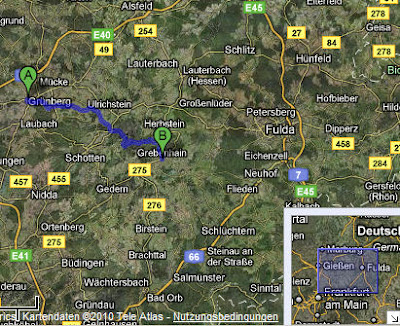Wenn es also diese apostrophierte Namens-Entwicklungsverwandtschaft VIANT/VENDT/WIEAND tatsächlich gibt, hat sich folgende neue Spur ergeben:
1
aus: http://www.chronik-crainfeld.de/auswanderer.htm
| Auswanderer nach Ungarn 1720/21 Den Hintergrund für die erste größere Auswanderung in der Geschichte des Vogelsberges bildete die hemmungslose und rücksichtslose Jagdleidenschaft des Landgrafen Ernst Ludwig von Hessen-Darmstadt (1678-1739). Durch das überhand nehmende Wild, die Parforcejagden über Äcker und Wiesen, und die Erhöhung der Steuern wurden insbesondere die oberhessischen Bauern wirtschaftlich ruiniert. Auch die stark zugenommene Bevölkerung nach dem 30jährigen Krieg, die aufgrund der in Oberhessen gültigen Realteilung zu einer Verkleinerung der Güter geführt hatte, dürfte mit ursächlich gewesen sein. Ab 1720 erschienen in der Landgrafschaft Hessen gezielt Werber im Auftrag des römisch-deutschen Kaisers und ungarischen Königs aus dem Haus der Habsburger, Karl VI., die Siedler für die brach und wüst liegenden Gegenden im kurz zuvor in den Türkenkriegen gewonnenen Ungarn und Siebenbürgen suchten. Trotz der Obstacles to those ads by the Landgrave's officials hiked 1720/21 a total of 300 persons from the Upper Hessian offices Alsfeld, Grebenau, Lißberg Nidda and into Hungary. Crainfeld emigrated from at least seven people from the neighboring Bermuthshain two families. The following information on the emigrants from the Kingdom of Hungary Crainfeld the Hessian archive documentation and information system (HADIS) and the publication "Grebenhain. Past and present of the villages in the southeastern mountain bird" taken in 1995. |
| Bauermeister, Johann Jost, source: bad roads. - Surname: after 1721 / destination: Hungary. - Spouse: Helen Catherine B., b. Wacker / Crainfeld, 1 child (ren). - Remarks: cop. on 23.02.1719 in Crainfeld. Source: Emigration Database Ernst Wagner, D. Luth. Hungary |
| Bauermeister, Susan, source: Crainfeld. - Emigration of: to 1721 / destination: Hungary. - Age / born: born: 21.11.1719, parents: John B. Jost, Katharina Helene B., born in: Wacker.. Source: Emigration Database Ernst Wagner, D. Luth. Hungary |
| Jost, John, source: Crainfeld. - Emigration date: 1721 / destination: Hungary. Source: Emigration Database Ernst Wagner; history leaves the circle Lauterbach No. 39 |
| Wacker, Helen Catherine, Origin: Crainfeld. - Emigration date: 1721 / destination: Hungary. - Spouse: Johann Jost Bauermeister from bad roads. - Remarks: cop. with as on 02.23.1719, after Calazno 1721st Source: Emigration Database Ernst Wagner, D. Luth. Hungary |
| linker, Bernhard Müller Crainfeld, 1720 emigrated. |
| Krisch, John Philip, farmer from Crainfeld, born 08/09/1691 in Crainfeld, 1720 emigrated. |
|
2
Zoltán Tefner schreibt in seinem Aufsatz: Kolonisationsgeschichte der hessischen Sekundärgemeinde Kötsching/Kötcse (Beiträge zur Volkskunde der Ungarndeutschen 13, 1997)
Johann Viandt - from the "Fuldischen space" - died in 1788 at the age of 80 in Kötcse - ie born in 1708 ... he can have been as a son of that " Johann Vent from Crainfeld, Dyer of green mountain," - - from the "Fuldischen space" - and - as elsewhere Tefner stresses from the Vogelsberg area ...
In Urbarial Kötcse of 1767 of the initial three Wiand (t) s (George, Jacob and John) only a "Viganth" / "Viant" Janos (John) left ....
Kötcse / Kötsching is probably a secondary settlement - perhaps fed by the families in Györköny as Viandt over 100 years of constant appearing in the registers. You should have a special - albeit controversial - source connected to the "Hianzen" or to the "heathen peasants" , the "Hapauern" have (married to each other, sponsor choice for baptisms, etc.)
This "Hianzen-/Heidebauern-Gebiet" is in the Austrian Burgenland / Neusiedler Lake / West Hungary (Gyor-Moson-Sopron) to settle.
Johann Vendt 1720 but first - perhaps with a larger family, with siblings and almost grown sons - have arrived in Western Hungary (primary settlement) - and then he is and / or his elder sons as "Viant / Viandt" moved to Györköny (secondary settlement) (Friedrich Viandt - * 1711) - assimilated pretty now with the "heathen peasants" clan - and then another family branch to Kötcse around 1730.
3
I n West Hungary (Sopron, Gyor-Moson) diving - at least later - Family branches Wendt / Vendt / Fendt / Windt on
This is certainly a very bold hypothesis ... - But it is also somehow "plausible" - and displayed. The time will bring, such as "resilient" is it ...
mailto: info@eddywieand-sinedi.de
This is certainly a very bold hypothesis ... - But it is also somehow "plausible" - and displayed. The time will bring, such as "resilient" is it ...
mailto: info@eddywieand-sinedi.de


















